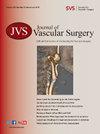Markers of optimal medical therapy are associated with improved limb outcomes after elective revascularization for intermittent claudication
IF 3.9
2区 医学
Q1 PERIPHERAL VASCULAR DISEASE
引用次数: 0
Abstract
Background
Optimal medical therapy (OMT) is a modifiable factor that decreases mortality and cardiovascular events in patients with severe peripheral arterial disease. We hypothesized that preintervention OMT would be associated with improved 1-year reintervention and major adverse limb event (MALE) rates after elective endovascular revascularization for intermittent claudication (IC).
Methods
Using the Vascular Quality Initiative (2010-2020), we identified patients with IC undergoing elective endovascular, hybrid, and open surgical interventions. Preoperative antiplatelet, statin, and nonsmoking status defined OMT components and created three groups: complete (all components), partial (1-2 components), and no OMT. The primary outcome was 1-year reintervention. Secondary outcomes included MALE and factors associated with OMT usage. Multivariable logistic regression generated adjusted odds ratios (aOR).
Results
There were 39,088 patients (14,907 [38.1%] complete, 22,054 [56.4%)] partial, 2127 [5.4%] no OMT) who met our criteria. Patients with any OMT were more frequently older with more cardiovascular diseases and diabetes (P < .0001). Patients without OMT were more likely to be Black or with Medicare or Medicaid (P < .05). Observed 1-year reintervention (5.3% complete OMT, 6.1% partial OMT, 8.3% no OMT; P < .001) and MALE (5.6% complete OMT, 6.3% partial OMT, 8.8% no OMT; P < .001) were decreased by partial or complete OMT compared with no OMT. Complete OMT significantly decreased the adjusted odds of reintervention and MALE by 28% (aOR, 0.72, 95% confidence interval [95% CI], 0.59-0.88) and 30% (aOR, 0.70; 95% CI, 0.58-0.85), respectively, compared with no OMT. Partial OMT decrease the adjusted odds of reintervention and MALE by 24% (aOR, 0.76; 95% CI, 0.63-0.92) and 26% (aOR, 0.74; 95% CI, 0.62-0.89), respectively.
Conclusions
Preintervention OMT is an underused, modifiable risk factor associated with improved 1-year reintervention and MALE. Vascular surgeons are uniquely positioned to initiate and maintain OMT in patients with IC before revascularization to optimize patient outcomes.
间歇性跛行选择性血管重建术后,最佳药物治疗标志物与改善肢体预后相关。
导言:最佳医疗疗法(OMT)是降低严重外周动脉疾病患者死亡率和心血管事件发生率的可调节因素。我们假设干预前OMT与间歇性跛行(IC)择期血管内再通术后1年再干预率和主要肢体不良事件(MALE)率的改善有关:利用血管质量倡议(2010-2020 年),我们确定了接受选择性血管内、混合和开放手术干预的间歇性跛行患者。术前抗血小板、他汀类药物和非吸烟状态定义了OMT的组成部分,并创建了三组:完全(所有组成部分)、部分(1-2个组成部分)和无OMT。主要结果是 1 年后再次干预。次要结果包括男性和与使用 OMT 相关的因素。多变量逻辑回归产生了调整后的几率比(aOR):39,088名患者(14,907人[38.1%]完全接受治疗,22,054人[56.4%]部分接受治疗,2,127人[5.4%]未接受OMT治疗)符合标准。接受过任何OMT治疗的患者多为年龄较大、患有心血管疾病和糖尿病的患者(p结论:干预前OMT是一种未得到充分利用的可改变的风险因素,与改善一年再干预和MALE有关。血管外科医生具有独特的优势,可以在血管再通术前启动并维持 IC 患者的 OMT,以优化患者的预后。
本文章由计算机程序翻译,如有差异,请以英文原文为准。
求助全文
约1分钟内获得全文
求助全文
来源期刊
CiteScore
7.70
自引率
18.60%
发文量
1469
审稿时长
54 days
期刊介绍:
Journal of Vascular Surgery ® aims to be the premier international journal of medical, endovascular and surgical care of vascular diseases. It is dedicated to the science and art of vascular surgery and aims to improve the management of patients with vascular diseases by publishing relevant papers that report important medical advances, test new hypotheses, and address current controversies. To acheive this goal, the Journal will publish original clinical and laboratory studies, and reports and papers that comment on the social, economic, ethical, legal, and political factors, which relate to these aims. As the official publication of The Society for Vascular Surgery, the Journal will publish, after peer review, selected papers presented at the annual meeting of this organization and affiliated vascular societies, as well as original articles from members and non-members.

 求助内容:
求助内容: 应助结果提醒方式:
应助结果提醒方式:


